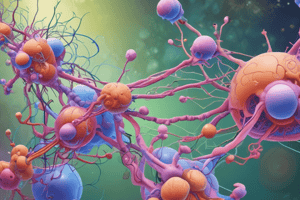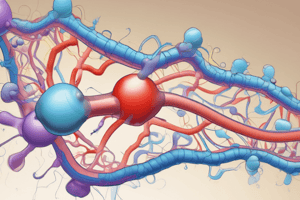Podcast
Questions and Answers
What percentage of marketed drugs target GPCRs?
What percentage of marketed drugs target GPCRs?
- 55-65%
- 25-35%
- 45-55%
- 35-45% (correct)
What is the approximate number of putative GPCRs in the human genome?
What is the approximate number of putative GPCRs in the human genome?
- 600
- 700
- 750 (correct)
- 500
What percentage of GPCR ligands are visual and olfactory?
What percentage of GPCR ligands are visual and olfactory?
- 40%
- 50% (correct)
- 30%
- 60%
What percentage of GPCR ligands are classified as orphans?
What percentage of GPCR ligands are classified as orphans?
What percentage of GPCR ligands are proteins?
What percentage of GPCR ligands are proteins?
What is the dominant class of GPCR ligands?
What is the dominant class of GPCR ligands?
Which type of GPCR ligands is the least well-represented?
Which type of GPCR ligands is the least well-represented?
Approximately what percentage of GPCRs are classified as orphans or have unknown ligands?
Approximately what percentage of GPCRs are classified as orphans or have unknown ligands?
What is the significance of GPCRs in the human genome?
What is the significance of GPCRs in the human genome?
What is the significance of GPCRs in the pharmaceutical industry?
What is the significance of GPCRs in the pharmaceutical industry?
Flashcards are hidden until you start studying
Study Notes
G Protein-Coupled Receptors (GPCRs)
- 35-45% of marketed drugs target GPCRs
- The human genome contains 750 putative GPCRs
Ligands of GPCRs
- 50% of ligands are visual and olfactory
- 7% of ligands are proteins
- 7% of ligands are biogenic amines
- 8% of ligands are peptides
- 7% of ligands are viral, lipids, nucleotides, calcium, and viral
- 20% of ligands are orphans (i.e., their natural ligands are unknown)
Studying That Suits You
Use AI to generate personalized quizzes and flashcards to suit your learning preferences.




